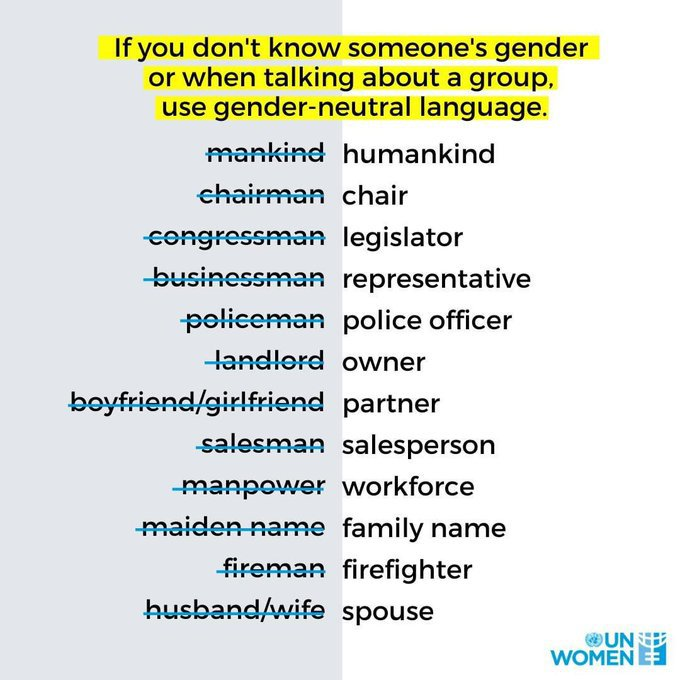Inclusive content: Why it’s necessary and how to get started
What does "inclusive content" mean? According to Salesforce, "it is content that truly reflects the diverse communities that our companies serve. It means that we are elevating diverse voices and role models, decreasing cultural bias, and leading positive social change through thoughtful and respectful content."
Creating inclusive content doesn't start and end at making a statement on social justice or taking a big stand on a hot topic. It requires us to think differently, recognize what we don't know, and use words more purposefully.
In the past year, we've had several opportunities to learn how language and imagery can be (and have been) used to marginalize and how we can choose respectful, inclusive messages that embrace differences.
In May 2020, the United Nations tweeted a list of gender-inclusive terms to promote greater awareness of gendered language.
In June, the Associated Press announced that it would be capitalizing the "b" in Black to "convey an essential and shared sense of history, identity, and community among people who identify as Black, including those in the African diaspora and within Africa."
Similarly, 2021 has seen social media platforms like LinkedIn and Instagram add pronouns on profiles to promote inclusivity.
As our societies become more interconnected, it's more important than ever that companies are thoughtful about the messages, images, voices, and values that represent their brands — as well as their notable social impact. Not doing so puts you at risk of excluding specific communities and also signals an unwillingness or inability to learn and grow.
I believe that our responsibility as marketers is to relay our brands' messages in a way that resonates with people regardless of race, gender identity, ethnicity, religion, age, sexual orientation, ability, or otherwise. Here are some principles to help you create a more inclusive content strategy for your business.
Inclusive Language
The foundation of an inclusive content strategy is inclusive language. When we attempt to understand how language often makes assumptions about people, we can increase inclusivity. There are several ways we unintentionally reinforce dominant norms like language related to gender, sexual orientation, race, class, ability/disability, and age.
To understand what it means to use inclusive language, it's helpful to compare it to language that isn't inclusive:
Ableist Language: Ableist language is any word or phrase that devalues people who live with a disability. Though often unintentional, ableist language suggests that people with disabilities are abnormal.
For example:
use "people with disabilities" instead of "the disabled"
use "people living with AIDS" rather than "AIDS victims"
ADD, ADHD, and OCD are common terms that are misused and can be hurtful. Obsessive-compulsive disorder is a mental illness that means so much more than a knack for organization. Use words like "clean" or "organized" instead
Gendered Language: Another aspect of inclusive language is making sure words are gender-neutral. Use words that encompass all genders rather than only two.
For example:
First-year student instead of Freshman
Parents instead of Mother/Father
Ancestors instead of Forefathers
Racial Undertones: The English language is littered with symbolism of white as positive and black as negative. Let's eliminate using the word "colored" when describing people. Instead, use "people of color," a widely accepted umbrella term that includes any non-white person.
Representation
Representation is the visible presence of various identities in a story, image, video, and more. People want to see themselves reflected in the media — it helps us feel empowered, inspired, and heard. Before publishing an advertisement or hosting a panel, for example, ask: does this reflect society? Am I elevating diverse voices?
These questions should guide you to make more inclusive decisions in your content marketing.
Stereotypes
Most of us have seen ads that play into dangerous stereotypes but imagine a world where the marketing images around us destroyed these stereotypes rather than encouraged them. This is another way we can change the society around us.
We can start by rethinking what…
a CEO can look like:
love can look like:
Appropriation
Appropriation is often defined as taking or using an aspect from a minority culture without knowing or honoring its meaning. Extracting from people’s cultures, traditions, and personal experiences can be both subjective and sensitive. We can all lead with awareness and respect by being mindful of historical context and nuance, learning and honoring the culture, seeking guidance and diverse opinions, evaluating intent and impact, and elevating authentic voices.
In Conclusion…
Inclusivity is not a day's job. We need to stay curious and embrace the feedback that comes our way to improve every day. An open and honest dialogue is central to developing an inclusive mindset that will help us choose better words, enhance our content, and promote inclusion. One way to do this is to form a diverse review panel to help catch any concerns or improve marketing before it goes out the door.
The steps described in this article are just the beginning of a lifelong learning process. My advice? Keep your mind and ears open, be kind, and never stop asking questions.


